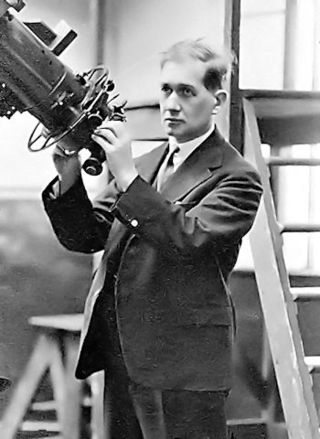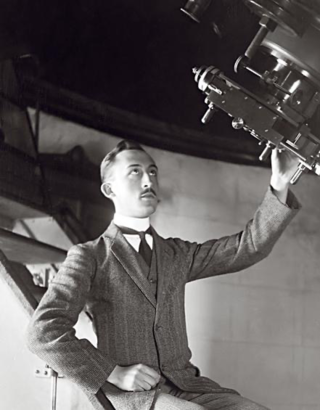Related Research Articles

Annie Jump Cannon was an American astronomer whose cataloging work was instrumental in the development of contemporary stellar classification. With Edward C. Pickering, she is credited with the creation of the Harvard Classification Scheme, which was the first serious attempt to organize and classify stars based on their temperatures and spectral types. She was nearly deaf throughout her career after 1893, as a result of scarlet fever. She was a suffragist and a member of the National Women's Party.

Edward Charles Pickering was an American astronomer and physicist and the older brother of William Henry Pickering. Along with Carl Vogel, Pickering discovered the first spectroscopic binary stars. He wrote Elements of Physical Manipulations.

Piet van de Kamp, known as Peter van de Kamp in the United States, was a Dutch astronomer who lived in the United States most of his life. He was professor of astronomy at Swarthmore College and director of the college's Sproul Observatory from 1937 until 1972. He specialized in astrometry, studying parallax and proper motions of stars. He came to public attention in the 1960s when he announced that Barnard's star had a planetary system based on observed "wobbles" in its motion, but this is now known to be false. On November 14, 2018, the Red Dots project announced that Barnard's star hosts an exoplanet at least 3.2 times as massive as Earth, though this does not match either of the planets he had claimed. In 2021, even this planet's existence was questioned.

Robert Thorburn Ayton Innes FRSE FRAS was a British-born South African astronomer best known for discovering Proxima Centauri in 1915, and numerous binary stars. He was also the first astronomer to have seen the Great January Comet of 1910, on 12 January. He was the founding director of a meteorological observatory in Johannesburg, which was later converted to an astronomical observatory and renamed to Union Observatory. He was the first Union Astronomer. Innes House, designed by Herbert Baker, built as his residence at the observatory, today houses the South African Institute of Electrical Engineers.
William Wilson Morgan was an American astronomer and astrophysicist. The principal theme in Morgan's work was stellar and galaxy classification. He is also known for helping prove the existence of spiral arms in our galaxy. In addition to his scientific achievements he served as professor and astronomy director for the University of Chicago's Yerkes Observatory in Wisconsin and was the managing editor for George Hale's Astrophysical Journal.
Sir Harold Spencer Jones KBE FRS FRSE PRAS was an English astronomer. He became renowned as an authority on positional astronomy and served as the tenth Astronomer Royal for 23 years. Although born "Jones", his surname became "Spencer Jones".

The Leander McCormick Observatory is one of the astronomical observatories operated by the Department of Astronomy of the University of Virginia, and is situated just outside Charlottesville, Virginia (US) in Albemarle County on the summit of Mount Jefferson. It is named for Leander J. McCormick (1819–1900), who provided the funds for the telescope and observatory.

Frederick Slocum was an American astronomer. He was the director of Van Vleck Observatory.

Samuel Alfred Mitchell was a Canadian-American astronomer who studied solar eclipses and set up a program to use photographic techniques to determine the distance to stars at McCormick Observatory, where he served as the director.

Ormond Stone, was an American astronomer, mathematician and educator. He was the director of Cincinnati Observatory and subsequently the first director of the McCormick Observatory at the University of Virginia, where he trained a significant number of scientists. He served as the editor of the Annals of Mathematics and towards the end of his life made donations which led to the founding of the Fairfax Public Library System.

The University of Illinois Astronomical Observatory, located at 901 S. Mathews Avenue in Urbana, Illinois, on the campus of the University of Illinois Urbana–Champaign, was built in 1896, and was designed by Charles A. Gunn. It was listed on the National Register of Historic Places on November 6, 1986, and on December 20, 1989, was designated a National Historic Landmark.

John Jackson was a Scottish astronomer.

The Kenwood Astrophysical Observatory was the personal observatory of George Ellery Hale, constructed by his father, William E. Hale, in 1890 at the family home in the Kenwood section of Chicago. It was here that the spectroheliograph, which Hale had invented while attending MIT, was first put to practical use; and it was here that Hale established the Astrophysical Journal. Kenwood's principal instrument was a twelve-inch refractor, which was used in conjunction with a Rowland grating as part of the spectroheliograph. Hale hired Ferdinand Ellerman as an assistant; years later, the two would work together again at the Mount Wilson Observatory.

James Bailey "Jim" Kaler was an American astronomer and science writer.

Robert Horace Baker was an astronomer.
Guido Münch Paniagua was a Mexican astronomer and astrophysicist.
Carlos Jaschek was a German-born Argentine astrophysicist who spent time in the United States, lived in Switzerland, settled in France, became a French citizen and worked to make astronomical data accessible to all nations. As the second Director of a new center in Strasbourg, France, designed to be a computerized repository for data about the stars, he was part of its early team who were determined, clearsighted decision-makers when its resources were limited.

Stavros Plakidis was an astronomer, professor, astrophysicist, mathematician, author, and director of the Astronomical Institute of the National Observatory of Athens and intermittently served as chairman of the National Observatory. He is considered the father of modern astronomy in Greece. Plakidis made systematic observations of variable stars, novae, planets, minor planets, stellar parallaxes, orbits of comets, and double stars, also contributing to the accurate geographic coordinates of the Athens Observatory. Plakidis independently discovered V1500 Cygni several hours after Minoru Honda claimed the find in Japan.
Reynold Kenneth Young was a Canadian astronomer. He served as first director of the David Dunlap Observatory from 1935 until 1946.
Arne Edwin Slettebak was a naturalized American astronomer who served as chair of the astronomy department at the Ohio State University from 1962 to 1987 and director of the Perkins Observatory from 1959 to 1978.
References
- 1 2 3 "Harold L. Alden". Virginia.edu. Archived from the original on 7 February 2015. Retrieved 11 December 2013.
- Sources
- Van De Kamp, Peter (March 1964). "Harold Lee Alden (obituary)". Quarterly Journal of the Royal Astronomical Society. 5: 291. Bibcode:1964QJRAS...5..291V.
- Harold Lee Alden Archived 2015-02-07 at the Wayback Machine